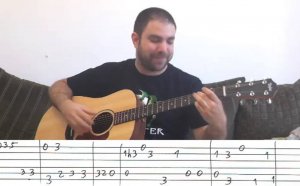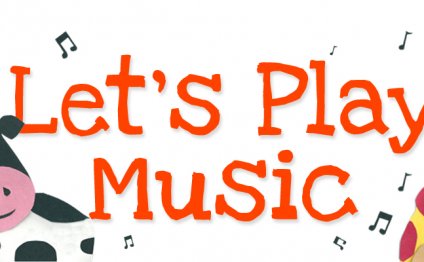
Free Printable piano lessons for Beginners
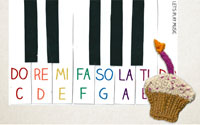 Happy Birthday must be one of the first and most important songs a child will learn. It has such a special significance and is one that that they will sing many times every year. So naturally it makes a really great piece for young pianists to learn. It is very popular for Birthday parties and it will go down so well with Granny!
Happy Birthday must be one of the first and most important songs a child will learn. It has such a special significance and is one that that they will sing many times every year. So naturally it makes a really great piece for young pianists to learn. It is very popular for Birthday parties and it will go down so well with Granny!
There are two easy piano music arrangements for Happy Birthday here: one for children who have only just started to play, which is the simple melody line centered on middle C that they will find quick to master, and an easy piano music arrangement for both hands together which is more suitable for someone who has been playing for a little longer.
Click here to print the very easy piano music (or click on the picture with the orange title), and here to print the easy piano music (or click on the picture with the purple title).
If you are new to the piano, use my six easy lessons in the First Piano Lessons Series to introduce the basic concepts of fingering, rhythm and notation. These lessons introduce children to playing the piano in a fun, engaging way. If your child or pupil is new to reading music, take a look at this post on How to Read Music Made Easy.
Happy Birthday Easy Piano Music for Beginners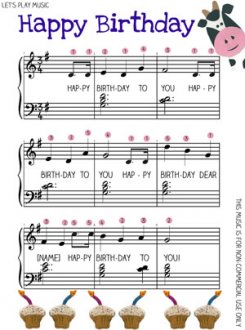 How To Play Happy Birthday Easy Piano Music
How To Play Happy Birthday Easy Piano Music
1. Place hands over the notes, with both thumbs (1s) on middle C.
2. To prepare, ask the child to play and name the notes C, D, E, F, G with the right hand 1, 2, 3, 4, 5 both up, and back down again. Then do the same with the left hand going downwards (they find this more difficult at first) C, B, A, G, F and back up again to middle C.
3. Look at the Happy Birthday sheet music and ask the child to work out the first note on “Ha-ppy”. This is G with the left hand finger 4. As they will know the tune already they should find it quite easy to work out the first phrase, but help them to notice what the jump (interval) is on “to you”. It is a 4th, this means they jump from 4 – 1 which is G – C.
4. The second phrase starts the same (so is just repeated) but point out the jump (interval) is one step higher (a 5th) from G – D, using the right hand fingers 2 -1 on “to you”. Practise these first two phrases a couple of times.
5. The third phrase starts again on G “Ha-ppy” in the left hand with 4th finger, but the jump is a whole 8 notes (octave) up to the G “Birth” in the right hand finger 5. Practise finding this jump a couple of times. The right hand then plays 3 -1 on “day – dear” and the left hand plays 2 – 3 on B – A which is where you insert the name of the Birthday boy/girl.
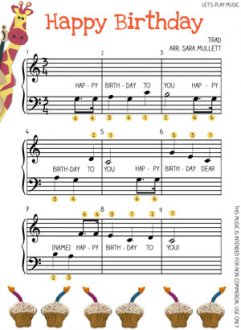 6. The fourth phrase is played by the right hand with the 4th finger on F for “Ha-ppy” then 3, 1, 2, 1, E – C – D – C on Birth-day – to you!
6. The fourth phrase is played by the right hand with the 4th finger on F for “Ha-ppy” then 3, 1, 2, 1, E – C – D – C on Birth-day – to you!
7. Once the child has identified all the notes it’s very good practise to sing the names of the notes as they play them. This is difficult at first and should be attempted very slowly and with no pressure, but it really checks that they fully understand what they are playing, and are not just relying on their memories!
Happy Birthday Easy Piano Music For Both Hands
This version is in the key of G major which has an F sharp (F#) .
Left Hand
1. First explain the key signature making sure the child is familiar with the F#. You could also play the scale of G major to help them understand the concept of different keys. Spend a little time finding the F# as well as spotting them in the music. Work out which finger plays them? Does the left hand have any? How many are there? There are only 2 in the right hand both times with 2nd finger.
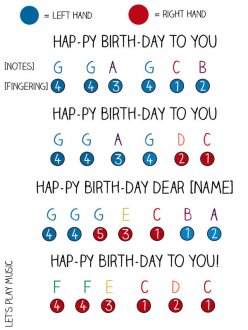 2. Start with the left hand, since this likely to be the most challenging, singing the tune along as you play the chords. Find the hand position for the first G chord by identifying the bottom note and explaining that basic chords are made with fingers 5, 3 & 1, and the bottom note is the key note (tonic), in this case G. Now look ahead and count all of the G chords (there are a lot!). The chords are mostly played on the first beat of the bar on the syllables ‘birth’ and ‘you’.
2. Start with the left hand, since this likely to be the most challenging, singing the tune along as you play the chords. Find the hand position for the first G chord by identifying the bottom note and explaining that basic chords are made with fingers 5, 3 & 1, and the bottom note is the key note (tonic), in this case G. Now look ahead and count all of the G chords (there are a lot!). The chords are mostly played on the first beat of the bar on the syllables ‘birth’ and ‘you’.
3. After the first G chord, in the 2nd bar the left hand fingers 1 & 2 play C & D. This should sound slightly clashing as it is what’s called a dominant 7th. The same chord is repeated for the 3rd bar, then bars 4 & 5 are G chord again. On the 7th bar, the thumb 1 & 3 each have to move up one note to E and middle C as the words sing the name of the name of whose birthday it is. On the last ‘birthday’ the chords are G chord, C&D for one beat on ‘to’ and finally a last G chord on ‘You!’
4. Practise playing the left hand while singing along with the tune as this helps with the rhythm.
Right Hand
5. The right hand tune is much easier to work out as it is so familiar. Spend a little time identifying and naming the notes before you play anything. Recognise the distance between the notes where the tune jumps, whether it is a 4th 1 – 4 or 5th 1- 5 on ‘to you!’. Notice the octave leap on the 3rd ‘Happy birthday’ work it out each phrase by phrase before you attempt to play it all the way through.
6. Once the right hand is ready, you can play one hand each together as a duet, swapping over to make sure you practise both hands.
7. Only attempt both hands together when they can play each hand easily and feel ready to try. The first couple of times, it might be helpful to prompt them verbally when they should change the chord in the left hand, or which note comes next in the right hand. It is really important to take a slow tempo and keep a relaxed approach, making light of any mistakes – the most important thing is to have a go and have some fun!
YOU MIGHT ALSO LIKE
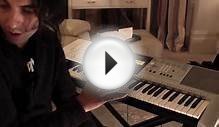
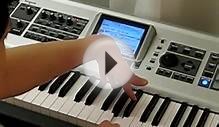
Share this Post
Related posts
Acoustic Blues Guitar Lessons for Beginners
Every guitar player experiences a major turning point early on in their education. After the requisite, and often times…
Read MoreYouTube Guitar lessons for Beginners acoustic
How to Get the Most from Your YouTube Learning Experience Want to improve your playing, but don’t have money or time to dedicate…
Read More

